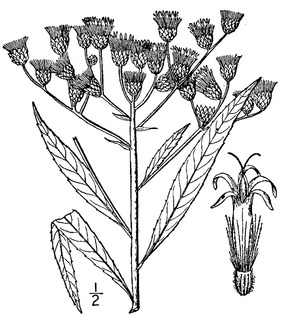Vernonia gigantea facts for kids
Quick facts for kids Vernonia gigantea |
|
|---|---|
 |
|
| Scientific classification | |
| Kingdom: | |
| (unranked): | |
| (unranked): | |
| (unranked): | |
| Order: | |
| Family: | |
| Tribe: |
Vernonieae
|
| Genus: |
Vernonia
|
| Species: |
V. gigantea
|
| Synonyms | |
|
|
Tall Ironweed (Vernonia gigantea) is a special kind of plant that grows very tall. It is part of the family called Asteraceae, which also includes well-known flowers like sunflowers and daisies! This plant is originally from eastern North America, where it grows wild in many places.
Contents
All About Tall Ironweed
Tall Ironweed is a plant that truly stands out, especially because of its height. It's not just tall; it also has beautiful flowers that make it easy to spot. Learning about this plant helps us understand the amazing variety of life in nature.
What Does Tall Ironweed Look Like?
Tall Ironweed gets its name because it can grow to be very tall. Imagine a plant that can reach over 10 feet (about 3 meters) high! Its stem is strong and sturdy, helping it stand upright.
- Flowers: The most striking part of Tall Ironweed is its flowers. They are a vibrant purple color and grow in clusters at the top of the plant. These flowers usually bloom in late summer and early fall, adding a splash of color to the landscape.
- Leaves: Its leaves are long and narrow, with slightly toothed edges. They grow along the stem and are a deep green color.
- Seeds: After the flowers fade, they produce small seeds. These seeds have tiny bristles, which help them float on the wind. This allows the plant to spread its seeds to new places.
Where Does Tall Ironweed Grow?
Tall Ironweed is native to the eastern parts of North America. This means it has grown there naturally for a very long time.
- Habitat: You can often find this plant in open, sunny areas. It loves places like fields, meadows, roadsides, and along the edges of forests. It prefers moist soil but can also grow in drier conditions.
- States and Regions: It grows across many states, from the eastern coast all the way to the central United States. It's a common sight in many parts of its native range.
Its Role in Nature
Tall Ironweed is more than just a pretty plant; it plays an important role in its ecosystem. It helps support many different kinds of wildlife.
- Food for Pollinators: The bright purple flowers are a favorite for many pollinators. Bees, butterflies, and other insects visit the flowers to collect nectar and pollen. This helps the plant reproduce and also provides food for these important creatures.
- Support for Wildlife: Birds sometimes eat the seeds of Tall Ironweed. The tall, sturdy stems can also provide shelter for smaller animals.
- Soil Health: Like many native plants, Tall Ironweed helps to keep the soil healthy. Its roots hold the soil in place, which can prevent erosion, especially in open fields.
Life Cycle of Tall Ironweed
Tall Ironweed is a perennial plant. This means it lives for more than two years. Each year, it goes through a cycle of growth, flowering, and seed production.
- Spring Growth: In the spring, new shoots emerge from the roots that survived the winter. The plant starts to grow taller and develop its leaves.
- Summer Bloom: By late summer, the plant reaches its full height. This is when the beautiful purple flowers begin to open, attracting many insects.
- Autumn Seeds: After the flowers are pollinated, they develop into seeds. These seeds mature in the fall and are then dispersed by the wind or by animals.
- Winter Rest: As winter approaches, the above-ground parts of the plant die back. However, the roots remain alive underground, ready to sprout new growth when spring arrives again.

